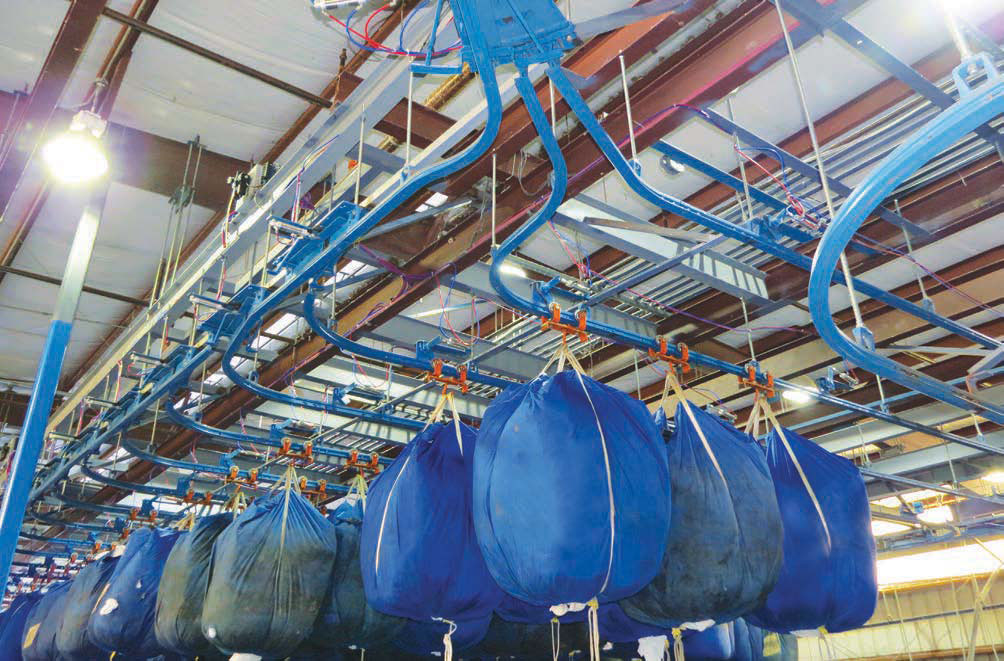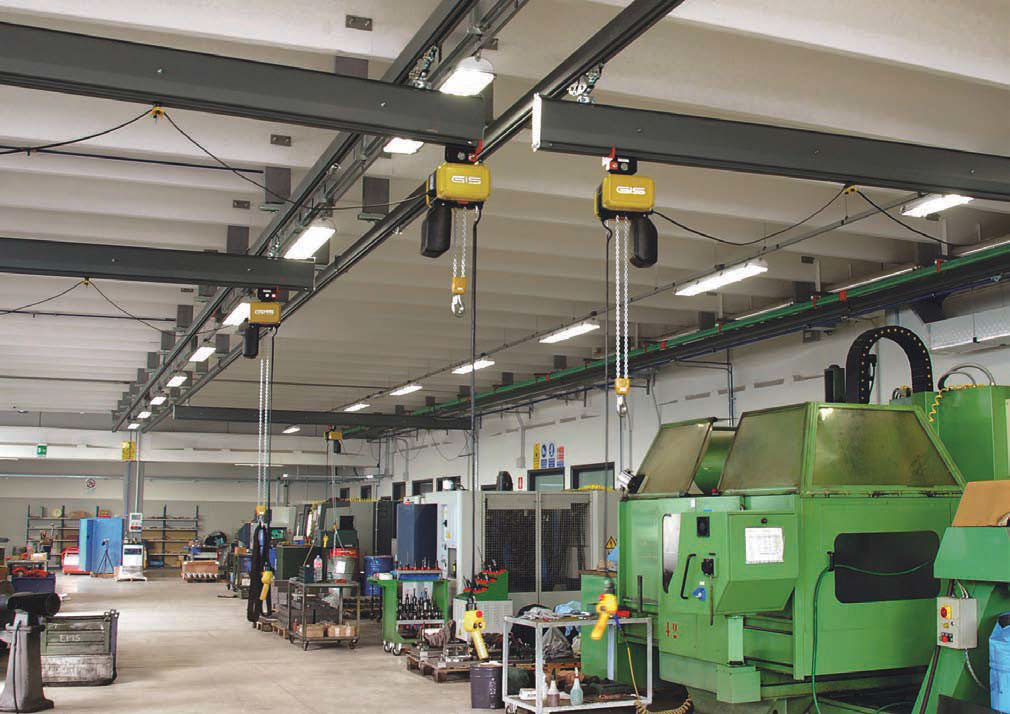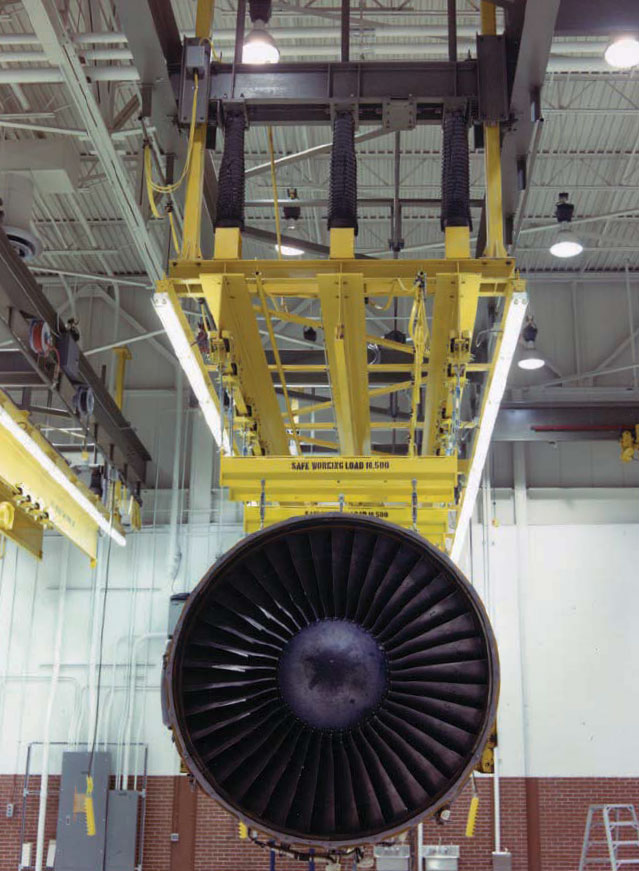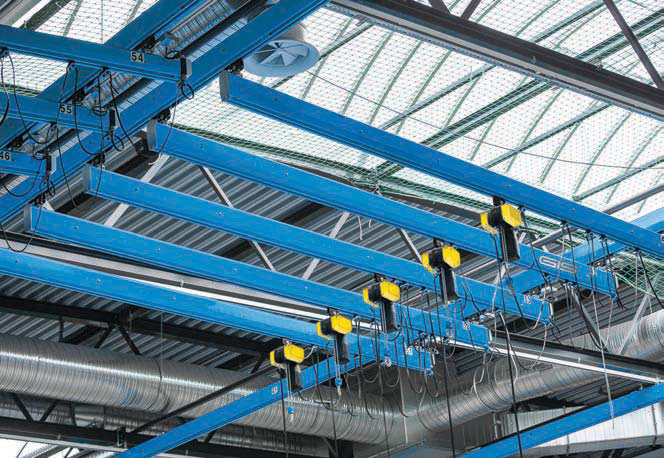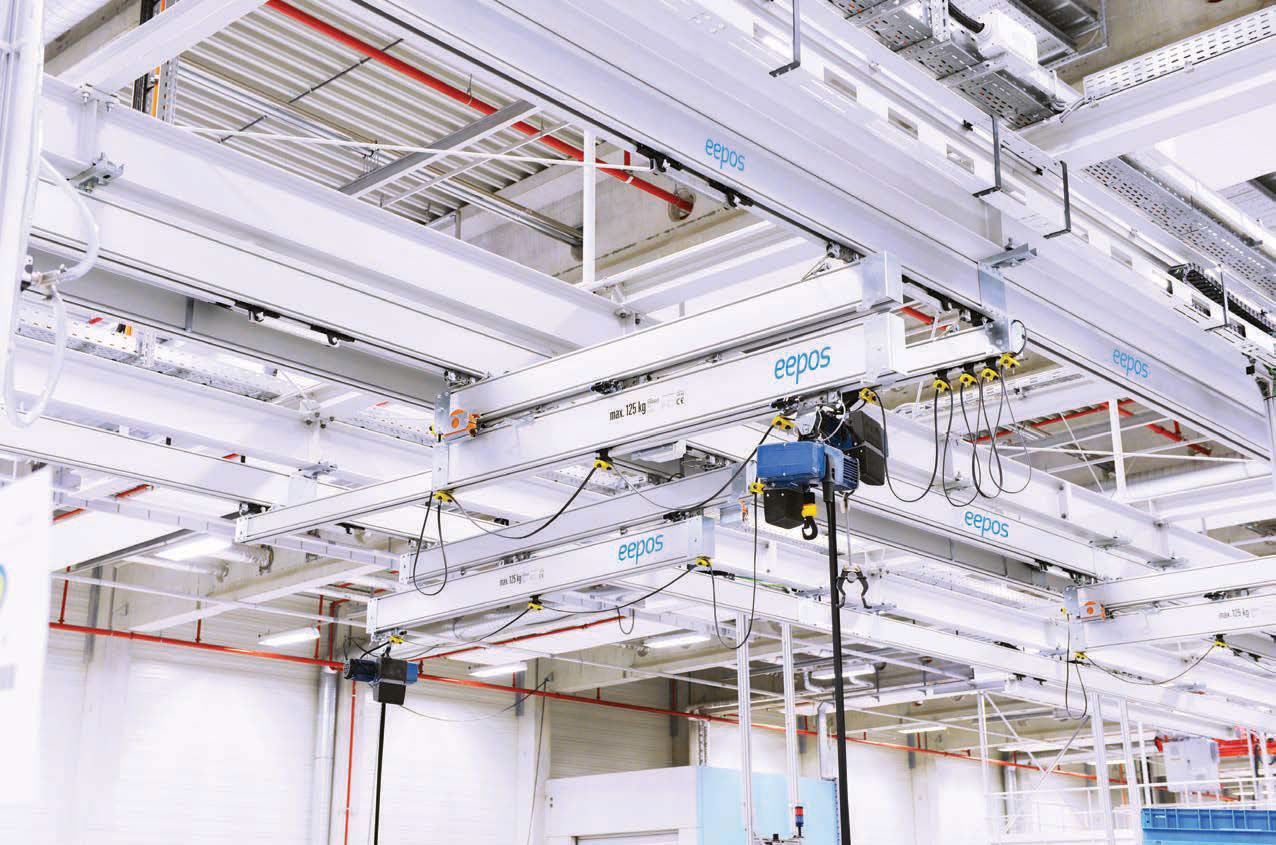Rolling on rails
25 September 2018The overhead monorail is a simple and robust way of moving loads in a factory. It has a long history but, as Julian Champkin finds, it has a future as well.
Dave Kelly, product manager at Acco, says: “Our company, makers of monorail systems for factories, was founded believe it or not in 1867—and we made our first monorail track system in the 1920s.” Which means that monorail technology is a hundred years old, give or take. It goes back at least as far as farmers suspending recycled railroad tracks in their barns to move animal feeds. It is, as Jerry Eischens, national sales manager of TC/American, says, a mature technology.
And it is a long-lasting one. “I am replacing monorails that our company installed in the 1940s,” he says. And, of the new systems that he is installing today, “I do not expect to visit them again in my lifetime.”
The reason for the longevity of monorail systems is that they have evolved to be ideal for their purpose. A steel-wheeled trolley slung beneath a steel I-beam leaves little obvious room for improvement. It is robust; it is simple; there is not much to go wrong. The trolleys are traditionally, and still to a very large extent today, moved along the tracks by hand, so there are no motors to burn out. If bearings wear out, any competent machine shop can fabricate replacements.
“For any process that needs to move objects regularly between two fixed points, there is no better means of delivery,” says Eischens. Which is not to say that there are no modern developments. The trackway is one.
Traditional I-beams are giving way to patented systems, with profiles that can be I-shaped, C-shaped, or inverted U-shaped. “Ours is a patented track system,” says Kelly. In fact it is two patented systems. Acco’s ‘Louden’ system runs on flanges that are three-and-a-third inches wide; its ‘Trambeam’ system runs on three-and-a-quarter inch flanges. Both come in light and heavy-duty versions; but both are aimed at the same markets, the same uses, and the same customers. The reason for two such similar systems?
“Acco patented the Loudon system first, decades ago,” says Kelly. “So the next company to enter the market had to make their monorails just a little bit different. When the two companies merged they But Acco’s tracks, both for Louden and for Trambeam, have moved on. Today their ‘Trojan-track’ girder is a three-piece fabricated section with lower plates surfaced to reduce friction and noise.
Materials too are changing. “All our rails are aluminium,” says Volkhardt Mücher, sales manager for Eepos. “That is partly, but only partly, because aluminium is lightweight. More importantly, we use aluminium for ergonomic reasons: for a smooth system you need a smoothly-guided trolley, and it is much easier to make precision rails from aluminium than from steel.
“Most trolleys on monorail systems are moved by hand. This is perfectly practical and easy even for weights up to 2t. People who try an Eepos system are surprised at how smooth it is and how little effort is needed to move the load. It is the precise production of the aluminium rails that makes that possible.
“Some makers of steel-railed systems claim that the lighter weight of aluminium is offset by its lack of strength. You do need larger cross-sections to carry the same weight that a steel trackway can manage, and so the saving is weight is reduced.
This is true, but as I said, we use aluminium primarily for the smoother ride that it can give. It is the precision that makes the difference.”
An alternative approach is offered by GIS. The Swiss company in June 2018 acquired the Bromsgrove-based Lift Turn Move (LTM). “Beam structure is important,” says LTM’s Stuart Fraser. “Most standard steel is not straight; to get it straight takes effort. Track obviously needs to be level.
Specialised adjustable support brackets are one solution.” And I-beams are not the only possibility. Inverted U-shapes allow trolley wheels to be protected from dust, says Fraser: “Lift Turn Move offers a U-shaped beam, in four capacities from our 0.8t KB1 to KB4, which has a 1.6t capacity. The beam to select depends not only on the load, but also on the distances to be spanned: you can have a longer span of lighter-weight beam if you are carrying lower loads.”
Different profiles offer different advantages. “Standard I-beams work fine in some applications, but when you move to curves and switches then you need something more sophisticated,” says Eischens. “TC/American makes patented track. In section it is a threepiece composite beam. But the lower flange is a consistent 3.25in wide regardless of beam height, allowing us to standardise trolleys and switches.”
Similar thinking comes from Eepos. “We do not use an I-beam but an enclosed, inverted U-shape profile,” says Mücher. “We make it in six different sizes, according to the capacity required; but, importantly, we make only one size of trolley, which fits all the differentlysized profiles. This makes it a completely modular system and so it is much easier to design. Of course designs are customised to the customers requirements.”
C-shaped profiles, or inverted U shapes, can accommodate conductor bars inside them, to power motorised trolleys, which we shall come to shortly.
Trolleys also have seen similar gradual but significant developments. They too tend to be modular, with more units added and connected together to carry heavier loads. “They can have two wheels, four wheels, six wheels, 16 wheels, according to the capacity required,” says Kelly at Acco.
“Trolleys tend to be four-wheeled, and, on motorised versions, can have either steel wheels or rubber tyres,” says Eischens. GIS offer the option of stainless steel wheels or plastic polymer; Eepos used plastic wheels, which they say gives very smooth running. “Our trolleys have pick-up wheels that carry the load, but they also have a middle wheel which copes with any negative, upward, forces that would tend to lift the trolley and jam it in the track,” says Mücher.
“This is a speciality of Eepos.” retained both systems.”
Tight Curves Ahead
Monorails do not have to run in straight lines only. Curves are not a problem, and can be of quite tight radius: Eepos point to their installation at the Lürssen shipyard in Bremen’s training school as an example.
Here, the company installed its aluminium monorail system in the building. A 2m hook height was needed, with the ability to transport a 1t load; a particular requirement was that the runway had to make a 90° turn between the entrance and the workshop.
When it emerged that the pillars of the building could not be moved due to the design of the hall, the existing steel construction had to be supplemented for the curved part of the track.
The Eepos monorail has become a standard feature in the training workshop.
“We use it for transporting steel and aluminium plates and for moving our assembly tables or presses,” says Lürssen’s training manager Dietmar Strauss. “Everyone who uses the crane is surprised how easy it is to move, even when there is a load attached. When we take the trolley from the training workshop around the corner to the gate everyone is cautious at first and then thrilled at how precisely the crane fits past the supports and pillars. We have now crane training including the attachment of loads, integrated into our training.”
Christian Schneider is a construction mechanic in his first year of training. “The Eepos crane runs incredibly smoothly in the crane runway,” he says. “What is interesting is that the weights on the crane are greatly underestimated.
Sometimes I think I am lifting 100kg when in fact it is 180 or 200kg. This is probably due to the very smooth and easy run.”
Tight curves can be achieved. “A 2in rail can bend to 1ft 8in radius of curve,” says Eischens. “2in is the smallest track that TC/ American provide; sizes go via 3.25in, 4in, and 4.5in bottom flange width; our largest, the 450 series, can have a 44in maximum height of rail.” When even this isn’t tight enough, turntables, offered by KBK/Demag and others, allow turns at right angles.
Nor do monorails have to deliver simply from A to B. As on a railway track they can have points or switches. “You can switch them,” says Fraser, “so that loads can be sent to any of several destinations—into and then out of a treatment bay, for example, before being sent to the right area for the next process. Smaller monorails have hand switched plates, bigger ones are electric.”
“Switches can be tongue, glide, rotary or customised,” says Eischens; “We customize them for their application. Every monorail can be automated, and we have some automated systems out there, but usually users tend to use manual switching; why change a system that works?”
Nor are monorails limited to horizontal movements. Acco offer a lifting section of rail to accommodate a factory where floor space is on two levels.
Powered trolleys are of course available. “As I said, 2t capacity can in most cases be pushed manually and is simple,” says Mücher. “We can automate the trolley with motors if a particular application requires it. We would suggest it for example where the distances to be moved are large.
“Electrical supply can come from a cable suspended at intervals; or via sliding contact onto a power-conductor bar either inside or outside the track; or we also use the IGUS energy chain, which can carry electrical or pneumatic power,” he says.
“Our C-rails have the conductor rail inside them,” says Fraser, “so there are no trailing cables. It is all about neatness: space is often very limited.”
Have It Your Way
When it comes to the hoist, most manufacturers are happy to leave the choice to their customers. “Our expertise is on the rail and trolley system, and we focus on that,” says Mücher. “Onto our trolleys we fit hoists from other manufacturers such as Demag or Kito.
This means that the customer’s maintenance engineers can choose the brands that they have elsewhere is the factory, which helps to ease maintenance procedures and logistics.”
Other manufacturers follow the same line of thinking. “We do make our own ‘Wright’ line of wire-rope hoists,” says Kelly, “but if a customer has a brand that he is used to we will happily sell him that.”
The 2t hand-pushable load is by no means the capacity limit for monorails. “We have done 20t systems; we have even done 40t,” says Kelly.
An obvious advantage of the monorail over other approaches to building a crane system, is that the rails are generally hung from the ceiling, giving an absolutely unobstructed workspace; but if the ceiling structure is not strong enough all manufacturers offer floor-based supports, in the form of inverted L-shapes or whatever best suits the customer: almost all installations are customdesigned from modular units.
“The market moves basically with the economy,” says Eischens, “and insofar as there are trends, they are in uses that customers are wanting from them. Just now aerospace and military spending are particularly strong in the US, so that is an area where we are making sales. In aerospace we have been installing large capacity monorails for jet engine testing, to carry the engines into the test cells. Those monorails could be 40t capacity.”
Specialised applications are also increasing. “The laundry industry is a perhaps unexpected application,” he adds. “We have a 2in product that serves that, with automation when it is required.”
Lift Turn Move have recently fitted a specialised monorail for the bulk bag food industry. “Flaking is an issue in a food plant,” says Fraser. “You don’t want fragments of steel from the rails falling into the product. The inside of our C-section track is self-finished; the wheels are plastic polymer; and that means you get no steel-on-steel abrasion. You avoid all the problems of flaking, and it gives smooth running as well.”
For the future, automation will come in, especially, says Mücher, in the form of digitisation for Industry 4.0.
